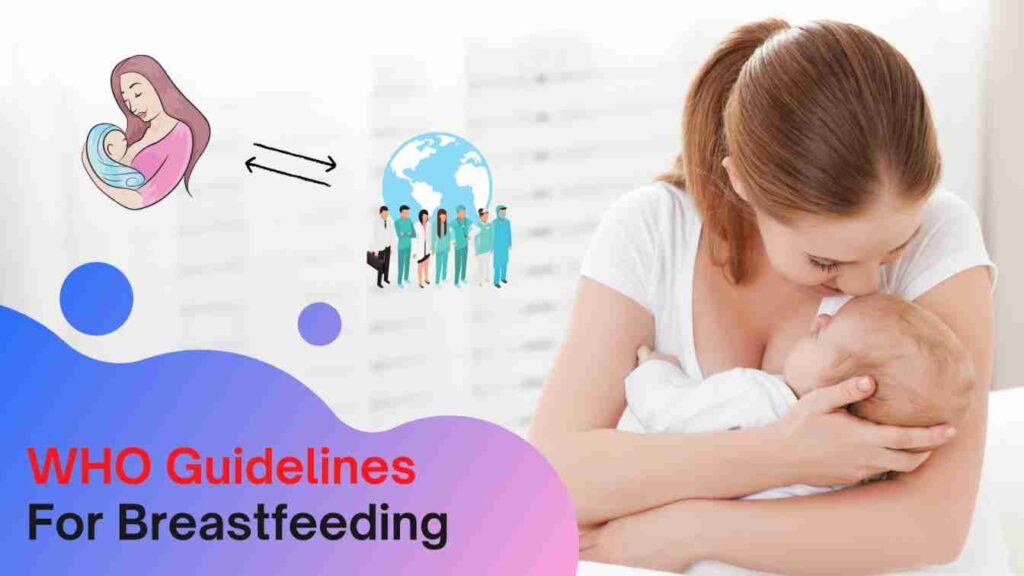
The first week of August is celebrated as the world breastfeeding week by the WHO[World Health Organisation].In this article let us delve into the scientific methods of breastfeeding, as guidelines by the WHO.
This year’s theme is “To support breastfeeding for a healthier planet“
Page Contents
ToggleBreastfeeding, From when to when?
As directed by WHO, breastfeeding must be initiated within an hour of delivery .and it should be the only food for the infant till 6 months.[not even water is needed].
WHO strictly recommends exclusive breastfeeding for infants up to 6 months and after which additional foods can be given along with breastmilk up to 2 years and later the child can be transformed fully to normal foods.
so in short, start: as early as possible
recommended time for shifting completely to other foods[i.e stopping breastfeeding]:-2 years
Now you know when to start, let us see how often should you feed your child!
The best answer is to feed according to the baby’s need, there is no fixed 3 time or 4-time schedule as we have. It is undesirable to feed the baby by the clock. Instead, Feed whenever your baby feels hungry. But it doesn’t mean you have to feed your baby 24*7, give yourself and baby some break, usually babies feed with an interval of 1-4 hours gap.
Colostrum - Breastfeeding Guidelines
It is the first milk that is ejected from the breast, which is yellow in color. This fluid is actually a magic potion that nature has bestowed on the mother. It is rich in carbohydrates and protein and has less fat content, so is the best nutritious food for your baby.
The fluid has abundant IgA antibodies which provide the baby protection from infections. After 3-4 days normal white-colored milk comes out.
Breast Milk Facts

An average woman produces around 450-600ml of milk /day.
It has a protein content of 1.1gm/100ml.
And a calorie of 70kcal/100ml.
Advantages of Breastfeeding
Benefits for babies:
- Infant mortality rates are 5-10 times low in countries where newborns are breastfed.
- It is the safest, cheapest, and cleanest food that you can provide for your infant, moreover it is automatically temperature regulated.
- It has antimicrobial factors such as macrophages, lysozyme, IgA antibodies, antistreptococcal factor… all these protect the newborn from several diarrheal diseases and other necrotizing enterocolitic diseases.
- Suckling-itself have its benefits-it is crucial for the development of jaw and teeth in the young ones.
- It is verified in a study that babies who are breastfed have a higher IQ than those who didn’t.[WHO & Park’s-Textbook of Social and Preventive Medicine pg-329-it is said that breastfed babies have a higher IQ by a factor of 8 than others]
Benefits for mother:
- Breastfeeding lowers the risk of postpartum hemorrhage and anemia in mothers.
- Boosts mother’s immune system.
- Lactational amennorrhea: provides time to space children[temporary infertility].
- It is also well seen that breastfeeding decreases the chance of both breast and ovarian carcinoma.[park-pg 329]
Covid-19 and Breastfeeding Guidelines
According to the latest information from WHO, Covid suspected or covid positive patients can breastfeed their child.
Although many studies have been conducted, it is not evident that the virus can spread through milk.
So if we weigh the potential risk of not breastfeeding the baby vs risks of contracting the virus, the former is more severe and dangerous. Therefore it is advised to still breastfeed the baby and measures such as kangaroo mother care are allowed.
What about Covid vaccinated mother?
WHO does not recommend discontinuation of breastfeeding due to vaccination, so don’t hesitate, go and have your shots taken ASAP.
WHO guidelines for Breastfeeding in HIV mothers
If we ponder over the latest information from WHO, it is said that HIV patients can still breastfeed,[as long as they are fully supported for ART adherence]for at least 12 months.
Mixed feeding is not a reason to stop exclusive breastfeeding in the first 6 months of the baby.
for more details, see this pdf: WHO HIV positive individual breastfeeding
10 Steps in Breastfeeding Guidelines
1. HOSPITAL POLICIES
- Not promoting infant formula, bottles, or teats
- Making breastfeeding care standard practice
- Keeping track for support for Breastfeeding
2. STAFF COMPETENCY
- Training staff on supporting mothers to breastfeed
- Assessing health workers knowledge and skills
3. ANTENATAL CARE
- Discussing the importance of breastfeeding for babies and mothers
- Preparing women in how to feed their baby
4. CARE RIGHT AFTER BIRTH
Encouraging skin-to-skin contact between mother and baby soon after birth.
Helping mothers to put their baby to the breast right away.
5. SUPPORT MOTHERS WITH BREASTFEEDING
Checking positioning, attachment and suckling
Giving practical breastfeeding support
- Helping mothers with common breastfeeding problems
6. SUPPLEMENTING
Giving only breast milk unless there are medical reasons
Prioritizing donor human milk when a supplement is need
Helping mothers who want to formula feed to do so safely
7. ROOMING-IN
Letting mothers and babies stay together day and night
Making sure that mothers of sick babies can stay near their baby
8. RESPONSIVE FEEDING
Helping mothers know when their baby is hungry
- Not limiting breastfeeding times
9. BOTTLES, TEATS AND PACIFIERS
Counsel mothers on the use and risks of feeding bottles, teats, and pacifiers
10. DISCHARGE
Referring mothers to community resources for breastfeeding support
Working with communities to improve breastfeeding support services

We all got a life, let’s make it memorable. Travel a lot, observe everything, learn new things each day, and last but not least, do what makes u happy inside. Being a medico is a wonderful thing and spending my time to give you the most valuable and trusted news and article gives me immense satisfaction and contentment.
KNOWLEDGE IS THE TRUE POWER AND SHARING IT IS THE GREATEST CHARITY…!

1 thought on “WHO Released New Breastfeeding Guidelines for 2021”